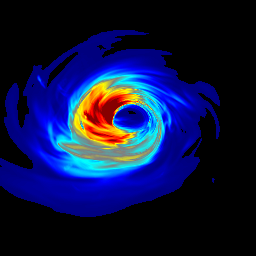Astrophysical Models
Although Sgr A* is the closest supermassive black hole candidate, the exact nature of its emission processes, dynamics, and geometry are still uncertain. The uncertainty is mainly due to free electrons in the spiral arms of the Milky Way (present between us and the Galactic center) which are scattering radio waves from Sgr A* and strongly distorting the intrinsic geometry of the source. Fortunately, around millimeter wavelengths, at which Event Horizon Telescope (EHT) operates, the effects of scattering become weaker and the true geometry of the source is expected to shine through.
Disk or jet ?
From the theoretical point of view there are currently two favored scenarios of what is going on around the Milky Way central supermassive black hole. One possibility is that Sgr A* radio emission is produced by disk of plasma (plasma is a fully ionized gas) falling onto the black hole. Another interesting possibility is that Sgr A* light is mainly produced by a relativistic jet launched from a dim disk around the black hole. Three-dimensional, fully relativistic magnetohydrodynamics (3-D GRMHD) computer simulations predict the observational appearance of such disk and jet scenarios at various radio wavelengths. Both models are shown in the figures below.






Fig 1. A radio emission models from 3D GRMHD simulations of disks (upper panels) and jets (lower panels) around the supermassive black hole. Panels from left to rigth show how near horizon emission looks like at 43, 86 GHz (at which the source was frequently observed with existing radio/mm-VLBI network) and 230 GHz (EHT frequency, high frequency radio/mm-VLBI). Here the effects of interstellar scattering of radio waves are not included, hence the images are clear and sharp. Credit: [Moscibrodzka, Falcke, Shiokawa, Gammie, 2014, A&A, 570, 7]
Notice that the shadow of the black hole – a dark, nearly circular shape in the middle of the images – is only clearly visible at high frequencies (230 GHz/1.3mm) at which EHT operates. At lower frequencies the black hole shadow is hidden behind the plasma surrounding the black hole that is obscuring the view. Interestingly, at EHT frequencies the light is emitted by disk or jet plasma in the immediate vicinity of the event horizon. Hence, the images are strongly affected by gravitational lensing and relativistic Doppler effects. For example, the lensing allows us to see what is behind of the black hole. Also, the asymmetry in the brightness, with the strongest emission to the left of the photon ring, is due to Doppler boosting of the material moving towards us.
Is light polarization a key to solve the mystery of Sgr A* emission?
The observed Sgr A* emission is polarized and this means that it is produced by electrons gyrating around magnetic field lines in so called synchrotron process. Theoretical models also predict how black holes with their disks and jets look like in polarized light. Comparison of model linear and circular polarizations to the observational data will allows us to identify the correct scenario. Only polarization of Sgr A* light permits to constrain the geometry of the magnetic fields near the black hole event horizon and it is possibly the only way to find out what Sgr A* radio source really is.


Fig 2.Disk and jet models in polarized light at 230 GHz (EHT frequency). Left panels: radiation intensity map similar to those shown above together with the polarization ticks. Polarization ticks show the plane in which the electric vector of the incoming electromagnetic radiation is oscillating. Middle and right panels show how strongly the light is linearly and circularly polarized. No interstellar scattering effects are included in these models. Credit: Moscibrodzka 2017.
Go [here] to see how the theoretical simulations of black holes can be directly compared with VLBI imaging experiments.



